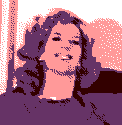|
Life on Earth (1994)
for
performance poet and CD
This
piece was premiered at the CCRMA Concert at Campbell Recital, Stanford
University, on November 15, 1994 by:
April Eiler, performance poet and co-creatrix
Life on Earth, conceived
as a musical backdrop to a dramatic reading by the poet, April Eiler,
mirrors the tripartite form of the poem for which it is named. The first
section of the poetry/music depicts cooperation in an innocent primitive
world; the second, pain, disillusionment and fear in the face of evil;
and the third, reaching out in blind faith for something or someone
to trust. As suggested by the meaning of the poem, the music is through-composed
with activity somewhat circumscribed so as to enhance but not overpower
the poetry. In the first section, a canvas of sustained voice-like parts
with a generally upward motion underpaints counterbalancing strokes
of ostinati based on a descending tetrachord. Koto and shamisen melodies
generated by statistical processes on the computer add layers of increasing
activity to underpin the dramatic climax of the first section. After
the solo recitation of the second section of the poem, an angular interlude
for drum, bassoon and tubular bell, influenced by the Afro-Haitian dance
Ibo, fades in to support a prominent, metrically loose, folk-like violin
melody based on the a harmonic minor scale. In the third section, a
rhythmic drone on the shamisen sets up the expectation of new material.
Superimposed on this drone are both chordal and arpeggiated ostinati
from the F-major pentatonic scale in contrasting registers as well as
the final lines of the poem.
Ouroboros-Life on Earth
was composed for the multimedia exhibit Visual Cymbals, sponsored by
the South Bay Women's Caucus for Art at San Jose State University Art
Gallery. Artist Nina Koepke and poet April Eiler collaborated on the
sculptural/poetic/musical installation called Ouroboros after that ancient
symbol of rebirth. The musical ideas were generated on the Next computer
using Stella and Common Lisp Music (CLM), extensions of Common Lisp
specifically designed for algorithmic composition and sound synthesis,
respectively.
|



